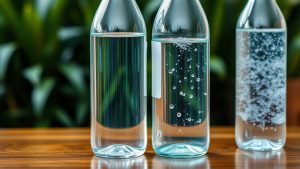
Purified water undergoes methods like activated carbon filtration and reverse osmosis to remove impurities while retaining beneficial minerals. In contrast, distilled water is produced by boiling water and condensing steam, resulting in a completely mineral-free product. While both types eliminate harmful contaminants, purified water is often deemed healthier for regular consumption due to its mineral content. If you want to uncover more about their production processes and health impacts, there's much more to explore.
When you reflect on the differences between purified water and distilled water, it's vital to understand their definitions and the processes behind their production. Purified water is treated through various purification methods such as activated carbon filtration, reverse osmosis, or deionization to remove impurities. In contrast, distilled water is produced through distillation, where water is boiled to create steam, which is then condensed back into liquid form, effectively isolating it from contaminants.
While both types can achieve high purity levels, the distillation process is more energy-intensive and strips away all minerals, making distilled water completely mineral-free. The purification methods play an important role in the quality and characteristics of the water you consume. Distillation is highly effective for eliminating bacteria, viruses, and chemicals like sulfates and lead. Additionally, distilled water is beneficial for individuals with weakened immune systems due to its high purity.
Distillation removes all minerals, making distilled water highly pure yet completely mineral-free, effective against contaminants like bacteria and lead.
On the other hand, purified water can be produced using techniques that retain some beneficial minerals, which are often absent in distilled water. For instance, reverse osmosis removes dissolved solids while being more energy-efficient than distillation. Activated carbon filtration is frequently employed in the initial stages of purification to eliminate organic compounds, while deionization and ion exchange further enhance water purity by targeting ionic contaminants.
From a health perspective, drinking distilled water can be beneficial for individuals with weakened immune systems due to its high purity. However, for regular consumption, purified water is generally regarded as the healthier option since it retains essential minerals important for your body's functioning. Distilled water lacks minerals like calcium and magnesium, making it less ideal for daily use.
While both types of water are free from harmful contaminants, you may need to reflect on supplementing with essential minerals if your diet lacks them. The environmental impact of these purification processes is also worth noting. Distillation consumes a considerable amount of energy, which can negatively affect the environment. In contrast, reverse osmosis, a method for creating purified water, is more energy-efficient.
However, both purification processes can result in water waste, especially in reverse osmosis systems. Proper storage of purified and distilled water is essential to prevent re-contamination, and you should evaluate the quality of water against environmental considerations when choosing a purification method.
In terms of applications, purified water is often preferred for drinking due to its cleanliness and mineral content, while distilled water finds its primary use in medical facilities and laboratories that require the highest purity standards. Both types can be beneficial for cooking, particularly when the quality of tap water is questionable.
In regions with poor tap water, purified water is a safer alternative. Additionally, distilled water is advantageous in machinery and systems where mineral buildup could pose problems. Lastly, the taste and mineral content of these waters differ markedly.
Distilled water often tastes flat due to the absence of minerals like magnesium and calcium, while purified water can retain some minerals, enhancing its taste. Understanding these differences can help you make an informed choice about which type of water best suits your needs.
Conclusion
In conclusion, while both purified and distilled water are cleansed of impurities, they differ in their purification processes and mineral content. Purified water can undergo various filtration methods, while distilled water is boiled and condensed. Think of them as two sides of the same coin; both serve the purpose of providing clean drinking water, but with unique characteristics. Choosing the right one for your needs hinges on your preferences for taste and mineral content.



